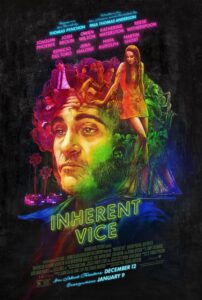Paul Thomas Anderson’s Inherent Vice in Search of a Lost Time

Written by Hami J.
“Thinks he’s hallucinating” is the first utterance used to address and describe the protagonist of Inherent Vice. Although he may not be hallucinating at the moment, a foggy vision of reality permeates and drifts through the air throughout the entire duration of the film adaptation of Thomas Pynchon’s Inherent Vice by Paul Thomas Anderson. Not far deviated from the book, the same-titled film revolves around a hippie private investigator Larry “Doc” Sportello (Joaquin Phoenix) as he is entangled by his former girlfriend, Shasta Fay (Katherine Waterston), in a series of interconnected mysteries within California’s extensive criminal network of the 1970s. In the face of the colossal scale of the enterprise, the clandestine nature of its elements, and its political landscape, Doc, a lonely waterfront cottage-residing pot-smoking private investigator, does not appear to stand a chance. However, as stated in Pynchon’s book, “if acid-tripping was good for anything, it helped tune you to different unlisted frequencies.”. Doc is virtually always stoned. Yet his altered state of mind often leads him to a heightend perception of his surroundings.

Historically, it was a time when the hippie anti-war counterculture movement of the sixties, championed by those whom in the aftermath of Manson Murders Ronald Reagan referred to as Tarzans, was gradually giving way to a more capitalist New Right conservatism. At such a time, the protagonist of the Inherent Vice, who is not a “do-gooder” but has “done good”, and whose sole material desire is drugs, comes to embody the spirit of an era on the verge of disappearing.
In his renowned essay, The Simple Art of Murder, Raymond Chandler argues that what constitutes a realistic detective story is a decadent world in which evil has almost won. In this world, “gangsters rule nations”, land and business owners have “made their money out of brothels”, and judges may be hypocrites, mayors can be murderers and so forth (Chandler 18-19). Of all these conditions one or two may suffice to add to or create a dramatic milieu.
Not only all these elements, and more, are entirely at play in the noir world of Inherent Vice, but they are also taken to a whole new level by their interconnectedness. This extensive corporate criminality is constructed by different components; namely, an Indochinese cartel that brings heroin ashore through an absurdly enigmatic vessel called The Golden Fang and secures its delivery by a neo-Nazi gang; a dentists’ syndicate, also called The Golden Fang, whose major profit comes from fixing heroine-affected dental deficiencies; a cult rehabilitation center where “vertical integration” is enabled by making the drug abuse something that can be got ridden of only to come back to again; as a result, “the cartel could always be sure of a bottomless pool of new customers”. And in cahoots with all these forces is the Los Angeles Police Department whose job is to assure the smooth execution of the entire affair.

The common thread to the interconnectedness of these sections is Capitalism. This is highlighted when Doc visits Chryskylodon, a private sector rehab center that screens anti-Communism propaganda for its patients on a regular basis. This is also where Mickey Wolfmann (Eric Roberts), a real estate mogul, is institutionalized in order to keep him from giving away his wealth to charity. The driving machinery of Capitalism hinges on growth. This growth, far outweighs the philanthropy of the regretful Wolfmann, infidelity of his wife, Chryskylodon’s bogus spirituality, business partnership of black militias and white supremacists, a corrupt L.A.P.D. and alike. This expansive capitalistic America, in which Doc Sportello lives, transcends people.
But how is Doc defined in this noir moral wasteland? Chandler specifies his ideal detective as someone “who is neither tarnished nor afraid”, a hero who is “everything”, a “complete man” yet “common” and “unusual”. He goes further by describing him as a relatively poor man who will “take no man’s money dishonestly”. He is “neither a eunuch nor a satyr”; he “might seduce a duchess” but will not “spoil a virgin”. Chandler believes he is “the best man in his world” (Chandler 9).
The melancholic burnout Doc Sportello is indeed the best man in his world. In fact, he is the only individual whose efforts lead to moral outcomes. Added for clarity in the film adaptation, Doc tells Sortilège—a rather minor character in the novel who is now the narrator of the film and who represents Doc’s consciousness—that what troubles him the most is that Coy Harlington (Owen Wilson), a saxophone player and agent provocateur, cannot see his baby again. Ultimately, he bargains for Coy’s discharge and in an ironic scene hands in loads of heroine to a mother and her daughter, the representatives of the Golden Fang. Conversely, the family-man hippie-hater Lieutenant Detective Bigfoot (Josh Brolin), “Doc’s nemesis and alter ego”, uses Doc as bait for his personal revenge scenarios. Nayman believes that the continuous clash between Doc and Bigfoot illustrates “the schism between hippie hedonism and authoritarian machismo”, and that the author’s as well as the audience’s sympathies are “consistently torqued in favor of the addled private-eye underdog” (Nayman 51). Although Doc has an office which is “like a day job and everything”, suggesting his slow succumbing to the transitional era, he is not so much interested in money as he is in drugs. In the cases he undertakes, his compensation is either not discussed or he is given word for a later pay. Considering his private life, despite his occasional affairs with the deputy district attorney, he is mostly a melancholic lover haunted by her ex-girlfriend in “his city dump of a memory” (Pynchon 163). All the similarities between Doc and Chandler’s version of a true detective aside, Doc Sportello is far from being a typical cliché cut out of a cardboard.
Other films have tried to characterize their detectives as an unreliable individual whose vision of reality is prone to question. In Robert Altman’s 1973 adaptation of Raymond Chandler’s The Long Goodbye, Phillip Marlowe is almost continually hung-over. However, he always maintains a stumbling grip on reality and is ultimately in control. After The Big Lebowski found its position as a new classic upon release, many other films have followed the same narrative by portraying a slacker protagonist’s actions while it spirals into a series of absurdly comical consequences. Being a victim of circumstances, most of the reluctant private dick figures of these films are left with no choice rather than pursuing the detection process.
While Inherent Vice may be considered a parody of the detective genre inasmuch as having a reliable skeptic detective is concerned, Doc’s encounters are “enfolded in an atmosphere (and mise en scène) that’s more generally melancholy” (Nayman 51) and leave Doc in an ambivalent position. Furthermore, in Anderson’s sentimentally nuanced rendition of the Pynchon’s novel, the love motive is profoundly foregrounded. Doc is primarily motivated by the appearance and later on disappearance of Shasta Fay, the noir femme fatale and also his ex-girlfriend. However, his involvement goes beyond an emotional level as he is willing to investigate further after Shasta’s sudden reappearance; an investigation through which he learns about the “sad history of L.A. land use” (Pynchon 17) and its interconnected organizations. Nevertheless, the latent operational architecture behind these elements remains eclipsed until the end.

This undermines the existence of truth altogether. Fundamental to every detective story, the detection of truth is the first and foremost epistemological problem. Here, too, Doc is on a quest to unveil the truth. He will succeed in his quest but does not necessarily reveal the truth. Crocker Fenway (Martin Donovan), the most important character Doc meets, is merely a representative of The Golden Fang, the ominous entity pulling all the strings. Each discovery leads to another and entangles Doc more firmly in the middle. Each piece of the puzzle he collects creates “an extra layer of fog on top of the one Doc was already standing inside of” (Inherent Vice). In this world, there is no end to digging for truth.
In Doc’s quest for truth, the central enigma around which all other components are positioned is The Golden Fang, a mysterious entity which is a schooner, among other things. A schooner which “brings stuff in and out of the country, but no one wants to talk about it”, and when different authorities are asked about it they “back off, change the subject and get really creepy” (Inherent Vice). It is a mysterious MacGuffin that comes from an island close to Bermuda Triangles and is always shown in a long shot. The schooner’s framing in the film and its supposed origins denote its untouchable nature. The Golden Fang, as the name suggests, stands for everything threatening. The paranoia-fueled Golden Fang symbolizes the corporate evil that unites as well as divides everything; perhaps an embodiment of what Pynchon describes as “the ancient forces of greed and fear” (130). It is what floats grimly off the California coastline where Doc dwells with his blissful dope-addled reality. Berressem describes the opposition between the beachside and the schooner as “the utopia of a laid-back, relaxed, self sustaining milieu” against “the urban and suburban machinations of the Golden Fang” (McClintock 54 ).
The Golden Fang also symbolizes change at the turn of the seventies. The night after Clancy, a minor character, tells Doc that his ex-girlfriend was “deeply in love” with the missing property magnate, his memory of a day with Shasta comes flooding back. The romantic flashback is about “one of those prolonged times of no dope”, when in total desperation Doc and Shasta call a random number generated by an Ouija board only to hear a woman abruptly telling them: “Howdy, dopers. We’ve got whatever you need. And remember the sooner you get over here, the more there’ll be left for you”. Apparently only a hallucination, they end up kissing passionately on the rainy streets next to a fenced empty land. This land, which once promised drugs, is turned, in present time, to a fang-shaped skyscraper called The Golden Fang, allegedly a syndicate for dentists. Thus, the spatial confiscation project of what used to be a lovemaking ground also becomes a temporal appropriation of an era. This is indicated when we see the white modern operation room of the tower is filled with hippie patients sitting on light umber seats, one of the counterculture’s popular earth tones. Apparently, the seats are color-coordinated with and thus appealing to the patients. The Golden Fang denotes the dissolution of the sixties pacifist counterculture into the unrestrained corporate culture of the seventies and consecutive decades.
In addition to the new circumstances, the duality in Shasta’s attire, appearing only twice in present-time, is suggestive of a change in times. In the beginning of the story, she appears out of the blue looking “just like she swore she would never look”, whereas Doc is in his dope-induced version of reality, idly staring out the window at the “sea of time, the sea of memory and forgetfulness”. While Doc as “a standin for countercultural resistance” (Nayman 50) has remained unchanged, Shasta’s new look which Doc describes as “a new package”—not to mention her headlong dive into an affair with the property mogul—is the herald of a new era. Lamentably describing this change, Pynchon writes in the novel: “the Psychedelic Sixties, this little parenthesis of light, might close after all, and all be lost, taken back into darkness” (254).
In his take on Inherent Vice, Anderson retains the absurd and complex Pynchonian vision of the world while transforming Doc Sportello and his world into a more comprehensible cinematic experience of a transitional era. In this only screen adaptation of the Pynchon’s oeuvre, classic conventions of the noir cinema is incorporated—a femme fatale as the plot-driver, secret organizations, corrupt authorities, an alienated antihero etc. Yet it is a postmodern psychedelic spin that twists and turns the genre as well. The omnipresent paranoic Golden Fang stands for the impending doom of the seventies: the ever-expansive machinations of Capitalism. The “dark crews” of this new period “had been busy all along, reclaiming music, the resistance to power” and “the sexual desire from epic to everyday” (Pynchon 0). Doc’s attempts to locate Shasta, and unravel the mysteries surrounding him, result from his resistance to the closing of an era. At the turn of the seventies, this transition ultimately brought about the suppression of the counterculture movement’s idyllic dreams. In his dope-addled resistance, Doc seeks to locate Shasta. He succeeds. Yet in the end their melancholic reunion does not mean they are “back together”. Shasta is gone and so is the sixties.

Pynchon, Thomas. Inherent Vice. New York: The Penguin Press, 2012. PDF
Anderson, Paul Thomas, director. Inherent Vice. Warner Bros., 2014.
Chandler, Raymond. Simple Art of Murder. Houghton Mifflin Company, 1950. PDF
McClintock, Scott, and John Miller. Pyynchon’s California. University of Iowa Press, 2014.
Nayman, Adam. Cinéaste, vol. 40, no. 2, 2015, pp. 50–51. JSTOR, www.jstor.org/stable/43500788.
Hill, Logan. “Pynchon’s Cameo, and Other Surrealities.” New York Times, 26 Sep. 2014, https://www.nytimes.com/2014/09/28/movies/paul-thomas-anderson-films-inherentvice.html.

